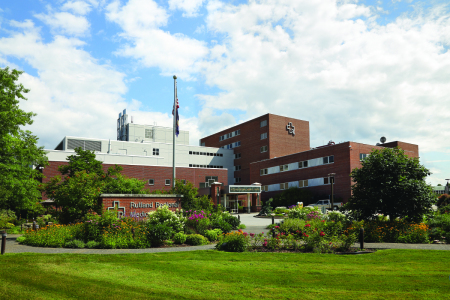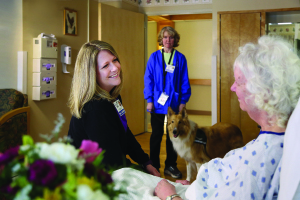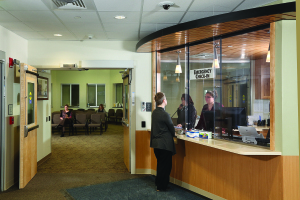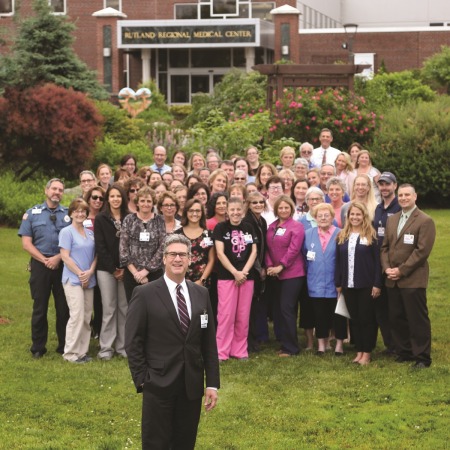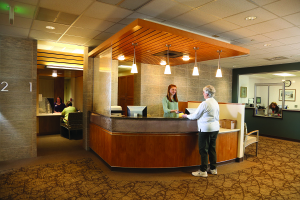Q&A with Dr. Daniel Mitchell
February 15, 2019
by Sean Ruck, Contributing Editor
Full disclosure: Recently, I had the opportunity to checkout this issue’s hospital spotlight firsthand. The experience was as good as one could hope for during an ER visit and I’m happy to say I’ve fully recovered. That said, I wasn’t waving around my press credentials and talking about the spotlight during my visit like a restaurant critic trying to get a free meal. I was just another patient and I was treated well. Still, it made me realize I had yet to cover the hospital in my own backyard. So that’s being rectified now with the interview that Dr. Daniel Mitchell, Medical Director of Diagnostic Imaging was so kind to grant just before the Christmas holidays.
HCB News: Who or what inspired you to pursue a career in healthcare?
Dr. Daniel Mitchell: I didn’t really have a dramatic moment where I said I wanted to be a doctor. I actually just kept following a path all through my education that I was the most interested in, and it kept leading me more into science and a little into math and engineering. It finally came to a point where I knew that it was just something I want to do. Before that, I was thinking maybe engineering or business management with an engineering/science background. But I realized that I wanted to go to medical school because it’s something that just fascinates me. But even at that moment, I didn’t know for sure if I wanted to be a traditional doctor or go into research or something. It was an ongoing process of making choices that aligned with skill sets and interests, and I ended up here. I wouldn’t have predicted it 35 years ago, but I’m very happy with where I am now.
HCB News: How long have you been with Rutland Regional?
DM: It’s been 17 years – I came here from Billings, Montana. I love Vermont. I was looking for a place where I could enjoy the outdoor recreation right out my own back door. Montana is beautiful, but I had to drive an hour and a half to get to the mountains from where I lived and it wasn’t as accessible year round.
HCB News: Does being a healthcare provider for a sparsely populated state present unique challenges?
DM: There are some unique challenges, but there are also some unique advantages. Certainly among the challenges would be the sparsity of the population. Not necessarily the resources available, but to some degree. The interesting twist is that although we’re a small hospital, we’re also in a state that’s very small and very rural. In any other state, a hospital our size would be really quite little and perhaps unimportant. But in Vermont, we’re the second largest hospital in the state and we are the largest community hospital. So this hospital has a lot of importance, a lot of clout and we get attention from the state regulators and legislators in terms of policy. They pay attention to us. It’s just a much more important link in the medical community than a similar sized hospital in a different state would be, and that’s an interesting position to be in.
HCB News: What attracts staff to Rutland Regional? I know you’ve touched on the outdoorsy aspect of the state, but are there other aspects such as the work culture?
DM: That’s actually something that I think is an advantage of a small hospital. You can change culture much more readily. It’s a small place in a small town and everybody knows each other. The culture here is very welcoming, very collaborative, and I think people are proud of that.
As far as attracting staff, there are two populations. One is the locals who grew up here and wanted to stay, and they can’t help but look at this hospital as the employer of choice in the area, which we are.
Then there are the people from out of town like myself, who see Vermont as the place they’d like to live, and its lifestyle. And similarly, it’s a great place to work. We tend to get a lot of applicants anytime we post a position. It’s a good place to be.
HCB News: Are there any big news items you’d like to talk about regarding the radiology department?
DM: We are constantly staying on top of technology, as you really have to in diagnostic imaging. We have new 3D breast imaging machines which we’re quite proud of. It’s the second generation of 3D tomosynthesis scanning for breast cancer. And we’re still the only hospital in Vermont to have it. The advantage of the second generation technology is that it’s a substantially lower radiation dose. The imaging quality is the same, but we’re delivering the lowest radiation dose of any FDA approved system on the market, in fact, lower than the conventional 2D imaging.
I don’t have data yet, but just anecdotally believe we’re finding smaller breast cancers. I’m very eager to see data at the end of one year to compare. That wouldn’t be surprising, based on nationwide data. We’ve also reduced the callback rate by about half.
In other big news, we’re almost finished with the construction for a new nuclear medicine scanner, which also has a fully capable CT unit in it. That’s an exciting new avenue for us. Overall, we’re constantly looking ahead in terms of technology, which is exciting.
HCB News: Is there any equipment currently on the radiology department’s wish list?
DM: I mentioned the nuclear medicine camera which is almost completed and the new CT scanner which isn’t a completed project, but we’ve already selected it and it’s in the process. On the wish list would be upgrading our MRI platform. That’s probably still a couple of years out, but you have to plan that far ahead. We’re doing really good things with our current MRI machine, but the core, the magnet, is 16 years old. We have state-of-the-art software we put on it to make the images, but it’s probably time to do an upgrade over the next two to three years and that’s on my wish list – to get a new magnet.
When the sales representatives from our vendors visit us, they’re always remarking on what we’re doing. For example, with our CT, they can’t believe how many scans we’re able to perform per year on one machine. Most radiology departments doing that volume of scans have two or three machines. The reason we’re able to do what we do is that the hospital has been very supportive and smart with how they allocate their resources. So for instance, if you have people working as transporters, and people who help get the patients changed, and those helping with all the clerical work, this leaves the technologist and radiologist to do the things they’re trained to do and not waste time more or less doing other tasks. We can have a very efficient use of that expensive equipment. That’s an advantage of a smaller hospital. We can be nimble and change to be more efficient where we need to be.
HCB News: What score would you give the radiology department on its interoperability with gathering data, speaking with the EMR, etc.?
DM: I would give us an 8 ½ and improving. For me, personally, everything is at my fingertips. There’s only one area of redundancy where I have to log again to look at something in the EMR if I’m at a particular place in a study, but that’s more of a minor annoyance. It’s still right there at my fingertips and we kind of solved that by having a separate little laptop that I log into next to the bigger workstations. The X-ray techs probably would say they have a little extra redundancy where they may have to put in some information more than once instead of it instantly populating across the field. That, too, is definitely getting better though. I know that recently we had an instance where the hospital put quite a bit of resources into solving an issue with an interface. We raised the issue and the hospital took it seriously and fixed it. There’s always room to be better, but I’m pleased people are willing to make the effort.
HCB News: Are you incorporating AI into your current radiology work?
DM: There are some niche applications that I’m pretty excited about. When we’re doing a CT for lung cancer screening, for instance, we have CAD that helps find tiny lung nodules, which is helpful, but it’s rare for it to find a nodule that I wouldn’t find myself. It’s nice to have the backup though. What I find particularly beneficial that it’s helping me to see how the nodules might be changing over time, since it measures the nodules and measures exactly the same way from year to year in a more precise manner than I could easily do. It gives me assurance that the nodule measurement is accurate. We also have CAD in some of our MRI and mammography.
HCB News: What is Rutland Regional best known for?
DM: I have to tell you, if I’m out in the community, I often hear people say they have confidence in the care we provide. Invariably, if I’m chatting with a patient before a procedure I’ll find there’s a connection. My wife is a native Rutlander, so I’ll hear “Oh, hey I know your wife’s family. I went to school with her uncle.” It’s a small town, there’s always a connection if you just take a moment to look. And there’s not a person in this community that doesn’t know several people who work at the hospital. So everyone regards it as “our hospital.” They see it as their hospital, but also see us staying on top of things with technology and care.
Rutland Regional Medical Center
Location: Rutland, Vermont
Year founded: 1896
Number of beds: 144
Number of employees: 1,734
President and CEO: Claudio Fort
Noteworthy distinctions: Rutland Regional Medical Center is Vermont’s biggest community hospital and the state’s second largest. They have 37 specialty clinics, and 277 medical staff treating over 250,000 patients annually. For the second year in a row, RRMC is the only hospital in Vermont to be named a “Best Regional Hospital” by US News & World Report for 2018-2019. They were also recognized by Healthgrades as among the top 10 percent in the nation, and the only hospital in Vermont for joint replacement and 5-star recipients for total knee replacement, total hip replacement and treatment of chronic obstructive pulmonary disease (COPD). For the sixth consecutive time, Rutland Regional was one of 855 hospitals out of 2600, and the only one in Vermont, to receive an “A” rating in hospital safety from the Leapfrog Group, and was also awarded the Advisory Board 2018 Workplace of the Year Award.
Specialties: Orthopaedics, cardiology, oncology, pulmonology, and women’s health
Recent developments: Rutland Regional continues to keep pace with the latest medical innovations, evidenced most recently by the installation of two new-generation 3D breast imaging machines. Rutland Regional is the first facility in Vermont to have this newest generation of three dimensional technology.
HCB News: Who or what inspired you to pursue a career in healthcare?
Dr. Daniel Mitchell: I didn’t really have a dramatic moment where I said I wanted to be a doctor. I actually just kept following a path all through my education that I was the most interested in, and it kept leading me more into science and a little into math and engineering. It finally came to a point where I knew that it was just something I want to do. Before that, I was thinking maybe engineering or business management with an engineering/science background. But I realized that I wanted to go to medical school because it’s something that just fascinates me. But even at that moment, I didn’t know for sure if I wanted to be a traditional doctor or go into research or something. It was an ongoing process of making choices that aligned with skill sets and interests, and I ended up here. I wouldn’t have predicted it 35 years ago, but I’m very happy with where I am now.
HCB News: How long have you been with Rutland Regional?
DM: It’s been 17 years – I came here from Billings, Montana. I love Vermont. I was looking for a place where I could enjoy the outdoor recreation right out my own back door. Montana is beautiful, but I had to drive an hour and a half to get to the mountains from where I lived and it wasn’t as accessible year round.
HCB News: Does being a healthcare provider for a sparsely populated state present unique challenges?
DM: There are some unique challenges, but there are also some unique advantages. Certainly among the challenges would be the sparsity of the population. Not necessarily the resources available, but to some degree. The interesting twist is that although we’re a small hospital, we’re also in a state that’s very small and very rural. In any other state, a hospital our size would be really quite little and perhaps unimportant. But in Vermont, we’re the second largest hospital in the state and we are the largest community hospital. So this hospital has a lot of importance, a lot of clout and we get attention from the state regulators and legislators in terms of policy. They pay attention to us. It’s just a much more important link in the medical community than a similar sized hospital in a different state would be, and that’s an interesting position to be in.
HCB News: What attracts staff to Rutland Regional? I know you’ve touched on the outdoorsy aspect of the state, but are there other aspects such as the work culture?
DM: That’s actually something that I think is an advantage of a small hospital. You can change culture much more readily. It’s a small place in a small town and everybody knows each other. The culture here is very welcoming, very collaborative, and I think people are proud of that.
As far as attracting staff, there are two populations. One is the locals who grew up here and wanted to stay, and they can’t help but look at this hospital as the employer of choice in the area, which we are.
Then there are the people from out of town like myself, who see Vermont as the place they’d like to live, and its lifestyle. And similarly, it’s a great place to work. We tend to get a lot of applicants anytime we post a position. It’s a good place to be.
HCB News: Are there any big news items you’d like to talk about regarding the radiology department?
DM: We are constantly staying on top of technology, as you really have to in diagnostic imaging. We have new 3D breast imaging machines which we’re quite proud of. It’s the second generation of 3D tomosynthesis scanning for breast cancer. And we’re still the only hospital in Vermont to have it. The advantage of the second generation technology is that it’s a substantially lower radiation dose. The imaging quality is the same, but we’re delivering the lowest radiation dose of any FDA approved system on the market, in fact, lower than the conventional 2D imaging.
I don’t have data yet, but just anecdotally believe we’re finding smaller breast cancers. I’m very eager to see data at the end of one year to compare. That wouldn’t be surprising, based on nationwide data. We’ve also reduced the callback rate by about half.
In other big news, we’re almost finished with the construction for a new nuclear medicine scanner, which also has a fully capable CT unit in it. That’s an exciting new avenue for us. Overall, we’re constantly looking ahead in terms of technology, which is exciting.
HCB News: Is there any equipment currently on the radiology department’s wish list?
DM: I mentioned the nuclear medicine camera which is almost completed and the new CT scanner which isn’t a completed project, but we’ve already selected it and it’s in the process. On the wish list would be upgrading our MRI platform. That’s probably still a couple of years out, but you have to plan that far ahead. We’re doing really good things with our current MRI machine, but the core, the magnet, is 16 years old. We have state-of-the-art software we put on it to make the images, but it’s probably time to do an upgrade over the next two to three years and that’s on my wish list – to get a new magnet.
When the sales representatives from our vendors visit us, they’re always remarking on what we’re doing. For example, with our CT, they can’t believe how many scans we’re able to perform per year on one machine. Most radiology departments doing that volume of scans have two or three machines. The reason we’re able to do what we do is that the hospital has been very supportive and smart with how they allocate their resources. So for instance, if you have people working as transporters, and people who help get the patients changed, and those helping with all the clerical work, this leaves the technologist and radiologist to do the things they’re trained to do and not waste time more or less doing other tasks. We can have a very efficient use of that expensive equipment. That’s an advantage of a smaller hospital. We can be nimble and change to be more efficient where we need to be.
HCB News: What score would you give the radiology department on its interoperability with gathering data, speaking with the EMR, etc.?
DM: I would give us an 8 ½ and improving. For me, personally, everything is at my fingertips. There’s only one area of redundancy where I have to log again to look at something in the EMR if I’m at a particular place in a study, but that’s more of a minor annoyance. It’s still right there at my fingertips and we kind of solved that by having a separate little laptop that I log into next to the bigger workstations. The X-ray techs probably would say they have a little extra redundancy where they may have to put in some information more than once instead of it instantly populating across the field. That, too, is definitely getting better though. I know that recently we had an instance where the hospital put quite a bit of resources into solving an issue with an interface. We raised the issue and the hospital took it seriously and fixed it. There’s always room to be better, but I’m pleased people are willing to make the effort.
HCB News: Are you incorporating AI into your current radiology work?
DM: There are some niche applications that I’m pretty excited about. When we’re doing a CT for lung cancer screening, for instance, we have CAD that helps find tiny lung nodules, which is helpful, but it’s rare for it to find a nodule that I wouldn’t find myself. It’s nice to have the backup though. What I find particularly beneficial that it’s helping me to see how the nodules might be changing over time, since it measures the nodules and measures exactly the same way from year to year in a more precise manner than I could easily do. It gives me assurance that the nodule measurement is accurate. We also have CAD in some of our MRI and mammography.
HCB News: What is Rutland Regional best known for?
DM: I have to tell you, if I’m out in the community, I often hear people say they have confidence in the care we provide. Invariably, if I’m chatting with a patient before a procedure I’ll find there’s a connection. My wife is a native Rutlander, so I’ll hear “Oh, hey I know your wife’s family. I went to school with her uncle.” It’s a small town, there’s always a connection if you just take a moment to look. And there’s not a person in this community that doesn’t know several people who work at the hospital. So everyone regards it as “our hospital.” They see it as their hospital, but also see us staying on top of things with technology and care.
Rutland Regional Medical Center
Location: Rutland, Vermont
Year founded: 1896
Number of beds: 144
Number of employees: 1,734
President and CEO: Claudio Fort
Noteworthy distinctions: Rutland Regional Medical Center is Vermont’s biggest community hospital and the state’s second largest. They have 37 specialty clinics, and 277 medical staff treating over 250,000 patients annually. For the second year in a row, RRMC is the only hospital in Vermont to be named a “Best Regional Hospital” by US News & World Report for 2018-2019. They were also recognized by Healthgrades as among the top 10 percent in the nation, and the only hospital in Vermont for joint replacement and 5-star recipients for total knee replacement, total hip replacement and treatment of chronic obstructive pulmonary disease (COPD). For the sixth consecutive time, Rutland Regional was one of 855 hospitals out of 2600, and the only one in Vermont, to receive an “A” rating in hospital safety from the Leapfrog Group, and was also awarded the Advisory Board 2018 Workplace of the Year Award.
Specialties: Orthopaedics, cardiology, oncology, pulmonology, and women’s health
Recent developments: Rutland Regional continues to keep pace with the latest medical innovations, evidenced most recently by the installation of two new-generation 3D breast imaging machines. Rutland Regional is the first facility in Vermont to have this newest generation of three dimensional technology.


